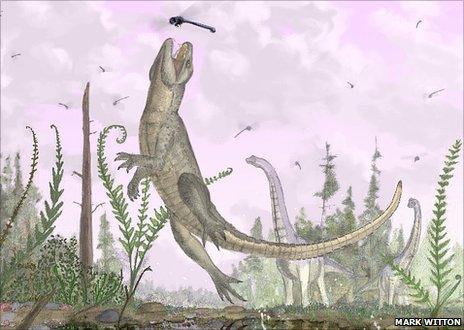Ancient 'cat-like' crocodile had bite like a mammal
- Published

Long ago, crocodile-like creatures might have hunted dragonflies
Palaeontologists working in Tanzania have unearthed fossils of a tiny crocodile-like creature with teeth resembling those of mammals.
The animal, Pakasuchus kapilimai, lived between 144 and 65 million years ago - during the Cretaceous - in what is now sub-Saharan Africa.
Scientists say the find shows that crocs were once more diverse than they are today.
The team reports its discovery in the journal Nature.
Paka means "cat" in Kiswahili, Tanzania's official language, and refers to the reptile's short, low skull with slicing, molar-like teeth.
Patrick O'Connor, associate professor of anatomy at the Ohio University College of osteopathic medicine, led an international team of researchers.
X-ray computed tomography gave a 3D view of the crocodilian's unusual bite
He said the new animal was a lot smaller than its modern relatives, adding that "its head would fit in the palm of your hand".
It also looked quite different from modern "crocodilians" - the group which includes alligators and crocodiles, he added.
"At first glance, this croc is trying very hard to be a mammal," said Professor O'Connor.
"If you only looked at the teeth, you wouldn't think this was a crocodile. You would wonder what kind of strange mammal or mammal-like reptile it is."
The scientists used X-ray computed tomography to analyse the creature's skull and jaw.
The digital images revealed that this reptile possessed dental features that had previously only been thought to exist in mammals, such as teeth with shearing edges used to process food.
According to co-author Nancy Stevens, also at Ohio University, the ancient reptile "occupied a dramatically different feeding niche than do modern crocodilians".
Dr Stevens explained that the tiny crocodile was able to bite and swallow just like mammals.
Typically, crocodiles have simple, conical teeth that serve to catch and tear prey.
Dr O'Connor and his colleagues classified Pakasuchus within an extinct crocodile group, the notosuchians, which lived sometime during the Cretaceous period.
At this time, the Earth was very different from today - a single landmass called Pangaea was in the process of dividing into smaller continents, including Laurasia in the north and Gondwanaland in the south.
"The presence of morphologically bizarre and highly specialised notosuchian crocodyliforms (crocodilians) like Pakasuchus in the southern landmasses, along with an apparently low diversity of mammals in the same areas, has potentially profound ecological implications," said co-author Joseph Sertich of Stony Brook University, US.
"This entire group of crocodiles deviates radically from the 'typical' crocodile, most notably in their bizarre dentition, demonstrating a diversification not seen in the Northern Hemisphere during this time interval."
Besides having strange teeth, it also had an extremely flexible backbone.
Scientists think the animal lived mostly on land and not in the water, probably hunting insects and other small animals to survive.